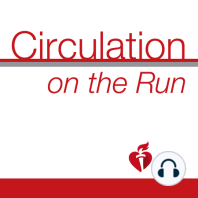16 min listen
Circulation December 5, 2017 Issue
ratings:
Length:
20 minutes
Released:
Dec 4, 2017
Format:
Podcast episode
Description
Dr. Carolyn Lam: Welcome to Circulation on the Run, your weekly podcast summary and backstage pass to the journal and its editors. I'm Dr. Carolyn Lam, Associate Editor from the National Heart Center, and Duke National University of Singapore. This week's journal features important information, that will aide identification of children with latent rheumatic heart disease, who are at highest risk of unfavorable outcomes. This important discussion is coming right up after these summaries. The first original paper this week describes the largest study to date to examine payer approvals and rejections of PCSK9 inhibitor therapy, and describe the patient characteristics associated with successful prescribing. First author, Dr. Hess, corresponding author Dr. Yeh and colleagues from Beth Israel Deaconess Medical Center in Boston, Massachusetts, performed a retrospective descriptive cohort study utilizing nationwide pharmacy claims linked to electronic medical records from a nationwide data warehouse. The data set included over 220 million patients from all 50 states, and all pair types with more than 5,000 distinct health plans. PCSK9 inhibitor prescriptions were submitted for 51,422 patients in the pharmacy data set. The authors found that among patients who were prescribed a PCSK9 inhibitor, 47% were approved for coverage by the payer. Variables that were associated with approval included age above 65 years, history of atherosclerotic cardiovascular disease, prescription by a cardiologist or a non-primary care provider, statin intolerance, longer statin duration, and non-commercial payers. Interestingly, higher LDL cholesterol levels were not associated with higher approval rates. Commercial third-party payers had the lowest approval rates of 24 from 4% and Medicare had the highest at 60.9%. Thus, rates of approval for PCSK9 inhibitor therapy are low, even for patients who appear to meet labeled indications. While a combination of clinical characteristics increase the likelihood of approval, payer type is the most significant factor. The next study identifies a novel mitochondrial localized protein that plays a role in cardiac dysfunction, remodeling, and heart failure. This protein is FUN14 domain-containing 1, or FUNDC1, a highly conserved outer mitochondrial membrane protein. In today's study, first author, Dr. Wu, co-corresponding authors, Dr. Xie and Zou from Georgia State University, and their colleagues, showed that in cardio myocytes, FUNDC1 bound to inositol 1, 4, 5-triphosphate type 2 receptor, to form mitochondria-associated endoplastic reticular membranes. These, in turn, modulate a calcium release from endoplasmic reticulum into mitochondria and the cytosol. FUNDC1 deletion lowered the levels of calcium in both mitochondria and the cytosol. A reduction at intracellular calcium resulted in mitochondrial fusion, mitochondrial dysfunction, cardiac dysfunction, and heart failure. In summary, this study identifies FUNDC1 as a novel mitochondrial localized protein that plays a role in maintaining mitochondrial dynamics, and cardiac function, and may therefore be a therapeutic target in heart failure. The next study takes a deep dive into the J-Curve phenomenon of systolic blood pressure by providing an experimental approach to an observational paradigm. First and corresponding author, Dr. Kalkman, from University of Amsterdam and colleagues assess the association between on-treatment systolic blood pressure levels, cardiovascular events, and all cause mortality in patients randomized to different systolic blood pressure targets in the pool database of the SPRINT-6 and ACCORD trials. For both the intensive blood pressure target of less than 120 millimeters mercury, and th
Released:
Dec 4, 2017
Format:
Podcast episode
Titles in the series (100)
Circulation August 30, 2016 Issue: Circulation Weekly: Your Weekly Summary & Backstage Pass To The Journal by Circulation on the Run
